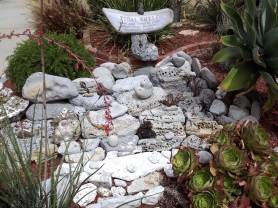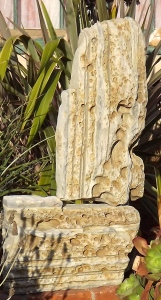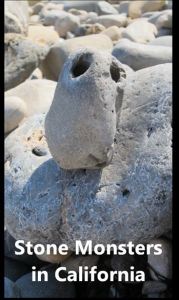Rocks and gardens serve as microcosms for larger natural forces and formations. In classic al Chinese gardens, taihu rocks, individually situated or piled into rockeries, were designed to evoke mountains. An oft-quoted passage from 18th century writer Shen Fu states that “in piling up rocks into mountains…the aim is to see the small in the large, and the large in the small, to see the real in the illusory and to see the illusory in the real.” The famous rockery at the Lion Forest Garden in Suzhou seen here features caves and tunnels under tall standing stones, simulating the vast caverns and striking peaks in renowned mountains like the Five Sacred Peaks.
al Chinese gardens, taihu rocks, individually situated or piled into rockeries, were designed to evoke mountains. An oft-quoted passage from 18th century writer Shen Fu states that “in piling up rocks into mountains…the aim is to see the small in the large, and the large in the small, to see the real in the illusory and to see the illusory in the real.” The famous rockery at the Lion Forest Garden in Suzhou seen here features caves and tunnels under tall standing stones, simulating the vast caverns and striking peaks in renowned mountains like the Five Sacred Peaks.
Pierre Jardin adopts a similar approach in working with stones and other materials, but adapts them to fit the geographical and geological context of his garden, coastal Southern California.  Thus his latest installation uses porous shore stones to stage a tidal shelf dotted with beachcombed rocks, seaweed, and coral meant to resemble birds, eggs, and small treasures one might find in tidal pools. In two texts, Pierre Jardin invites viewers to look closely at the display and let their imaginations speculate freely. A poem on the shelf’s headstone casts the “Tidal Shelf” as a set of tales and histories: “Swash zone tomes of stone/ Porous petric palimpsest/Sedimental stories.” The current Slow Times newsletter compares tidal shelves to wonder cabinets, and invites passersby to undertake a treasure hunt for specific objects in the display. As a viewer narrow their focus, they make the world of the display become larger in scale.
Thus his latest installation uses porous shore stones to stage a tidal shelf dotted with beachcombed rocks, seaweed, and coral meant to resemble birds, eggs, and small treasures one might find in tidal pools. In two texts, Pierre Jardin invites viewers to look closely at the display and let their imaginations speculate freely. A poem on the shelf’s headstone casts the “Tidal Shelf” as a set of tales and histories: “Swash zone tomes of stone/ Porous petric palimpsest/Sedimental stories.” The current Slow Times newsletter compares tidal shelves to wonder cabinets, and invites passersby to undertake a treasure hunt for specific objects in the display. As a viewer narrow their focus, they make the world of the display become larger in scale.
Behind the Tidal Shelf installation, three large, upright-balanced rocks loom. Pierre Jardin named them “The Holey Trinity” and imagines them as a set of tall coastal formations like one sees along beaches all around the world, from the Twelve Apostles in Australia to the Stone Henge pillars of Montaña de Oro State Park near San Luis Obispo.



